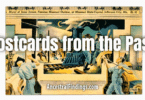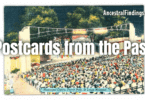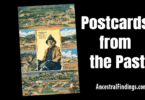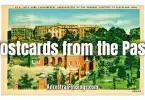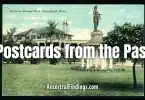This vintage postcard captures a sweeping view of Bridgeport, Ohio, and Wheeling Island in Wheeling, West Virginia. The Ohio River bends through the middle of the scene, crossed by several bridges that carr ied workers, families, and goods from one side of the river to the other. Postcards like this were small treasures of the early 20th century. They preserved local landmarks, and today they serve as important historical records for genealogists and historians alike.
Wheeling: A City of Industry and Growth
By the late 1800s, Wheeling had earned its place as one of the industrial giants of the Ohio Valley. Known as the “Nail City,” Wheeling became famous for its iron and steel production, particularly the cut nail industry that gave it its nickname. Glassmaking also flourished here, with factories producing window glass, bottles, and tableware. For families who lived in Wheeling during this time, employment was often tied directly to these industries.
Wheeling’s location gave it a strategic advantage. The city sat along the Ohio River and at the end of the National Road (U.S. Route 40), which connected the eastern seaboard to the interior of the nation. This made Wheeling a hub for commerce and migration. Thousands of immigrants, particularly Germans and Irish, settled here in the 19th century. They built businesses, joined churches, and formed communities that remain part of the city’s character today.
For genealogists, Wheeling’s industrial records, church registers, and immigration documents are invaluable. Many family lines in the region trace back to these waves of settlement.
Bridgeport, Ohio: A Partner Across the River
On the opposite bank of the river lies Bridgeport, Ohio. While smaller than Wheeling, Bridgeport developed in tandem with its West Virginia neighbor. Workers crossed daily into Wheeling for employment, and businesses in Bridgeport benefited from the river trade and railroads that ran through the region.
Bridgeport became known for its coal mining and its role as a residential community for workers employed in Wheeling’s factories. Many families lived on one side of the Ohio River and worked on the other, which made the bridges shown in the postcard essential lifelines.
Census records and city directories from Bridgeport and Wheeling often reflect this cross-river lifestyle. A researcher might find an ancestor listed as a steelworker in Wheeling, only to discover that he actually lived across the water in Belmont County, Ohio.
The Bridges of the Ohio River
The postcard prominently shows one of the iron bridges that spanned the Ohio River between Wheeling and Bridgeport. Bridges were more than just practical infrastructure—they were symbols of growth and opportunity. In Wheeling’s case, bridges helped unite two states and ensured that the economic benefits of industry spread across the region.
The most famous of Wheeling’s bridges is the Wheeling Suspension Bridge, completed in 1849. At the time, it was the largest suspension bridge in the world. Its construction drew national attention and cemented Wheeling’s reputation as a place of innovation. Other bridges followed, including iron truss bridges like the one pictured in the postcard.
For families of the early 20th century, these bridges were part of daily life. Workers commuted across them, children walked them to attend school or visit relatives, and travelers used them to cross the Ohio River without the need for ferries.
Wheeling Island: A Neighborhood on the River
In the center of the postcard view lies Wheeling Island. This natural formation became a thriving neighborhood. Families built homes and schools here, and by the early 1900s, the island had its own fairgrounds and racetrack. The Wheeling Island Racetrack became a major attraction, drawing visitors from across the Ohio Valley.
For genealogists, Wheeling Island represents a distinctive community to research. Families who lived there often appear in census records and city directories, with addresses simply listed as “Island.” Churches and schools kept records that provide a glimpse into island life, and newspapers reported on events at the racetrack, offering small clues about the daily routines of residents.
Immigration and Community Life
One of the most important aspects of Wheeling’s growth was the influx of immigrants. German immigrants, in particular, shaped the city’s cultural identity. They established breweries, churches, and social clubs that became central to community life. Irish immigrants also played a major role, especially in labor-intensive industries.
The presence of these immigrant groups is still visible today in the surnames found throughout Wheeling and Bridgeport. Genealogists researching families in this area often uncover German baptismal records, Irish Catholic parish registers, and fraternal organization memberships that provide insight into their ancestors’ lives.
Postcards as Historical Records
The handwritten note on this postcard—“Brother Frank”—may seem simple, but it represents a larger truth about postcards: they were often used for short, direct communication. For genealogists, postcards can be treasures. A name, even just a first name, can confirm family ties or point to relatives not yet documented in official records.
Postcards also freeze landmarks in time. Many of the buildings, bridges, and streets visible in old postcards have changed or disappeared. When paired with maps, city directories, or family letters, postcards can help researchers reconstruct the environment in which their ancestors lived.
Wheeling and Genealogy Research Today
For anyone tracing family lines in this region, Wheeling offers a wealth of resources:
- Ohio County Public Library holds historical newspapers, photographs, and special collections.
- West Virginia State Archives preserves birth, marriage, and death records that cover Wheeling families.
- Belmont County, Ohio Records provide insights into Bridgeport families across the river.
- Church Archives (both Catholic and Protestant) preserve baptismal, marriage, and burial records tied to immigrant communities.
Researchers should also consider the significance of industries. Employment records, union memberships, and even obituaries often mention the factories where individuals worked. For descendants of German immigrants, brewery records may hold clues; for Irish ancestors, steel or railroad employment may appear.
Why This Postcard Matters
This postcard of Bridgeport and Wheeling Island is more than just a pleasant view of the Ohio River. It documents an important chapter in the history of two states, two communities, and the families who lived and worked here. From the iron bridges to the bustling factories, from the immigrant neighborhoods to the unique life of Wheeling Island, this image captures a way of life that shaped thousands of families.
For genealogists, it is a reminder that family history doesn’t live only in census records and wills. It also lives in the small details—a scribbled name, a glimpse of a bridge, a river bending through two towns. Each postcard is a key that unlocks another piece of the past.
If you have postcards tucked away in albums or boxes that you’d like to share, I’d love to see them. You can reach out by clicking on the contact link, and I’ll be glad to provide my mailing address. From time to time, I may even share one of your postcards in the podcast so others can enjoy the history and stories they hold.


